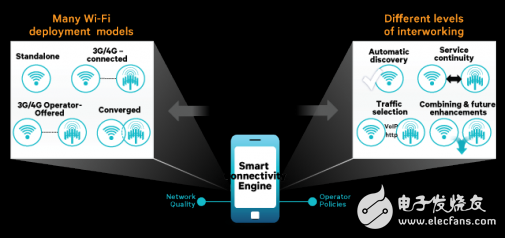Not long ago, when we first started talking about small cells, the first question we heard was always "Since we already have Wi-Fi, why do we need small base stations?" But now, this question quickly evolved into “How can we achieve stable and seamless collaboration between 3G/4G and Wi-Fi networks?†In the near future, the amount of mobile data will increase by 1000 times. In the face of such challenges, such collaboration will become even more important. Qualcomm envisions addressing this challenge by densely deploying small base stations, most of which integrate Wi-Fi connectivity. The integration and interoperability of 3G/4G and Wi-Fi is multi-dimensional, including different deployment modes and multi-level collaboration. Let's take a look at some details. Depending on the degree of integration, the most basic and current mainstream deployment model is an independent Wi-Fi network operated by a third-party vendor that can connect signaling to an authorized or authenticated 3G/4G network. The higher level mode is that 3G/4G operators provide their own Wi-Fi networks or services, which is often referred to as "operator Wi-Fi." In this case, the connection between the two networks may include not only a signaling connection but also a data connection. The most integrated model adopts a converged solution to provide 3G/4G and Wi-Fi networks in the same box, such as small base stations based on Qualcomm converged AP solutions. This is also the most likely way to deploy a small base station. Accordingly, at the integration level, the most basic third-party independent Wi-fi is that 3G/4G terminals can automatically search and connect to Wi-Fi networks without any user intervention, that is, using PasspointTM ( Also known as hotspot 2.0). The higher level is based on operator policy, intelligent choice between 3G/4G and Wi-Fi connectivity. For example, operators may want to provide high-quality services and their own services over 3G/4G networks, while offloading other services such as web browsing, downloads, and OTT services over Wi-Fi networks. The highest level of collaboration is to provide seamless, continuous service between 3G/4G and Wi-Fi networks. This means that the terminal not only automatically searches for and connects to the Wi-Fi network, but also seamlessly transfers data sessions between networks, and the user does not even notice these switches. The higher level of collaboration mentioned here already supports all of the situations mentioned above, and it also combines data from two connections or networks to make it more compact and stable. 3GPP is currently trying to implement these advanced features in Rel. 11 or higher. Regardless of the deployment model or the level of collaboration supported, the endpoint will always be able to select the best access among 3G/4G networks and numerous Wi-Fi connections at any given time. Of course, the choice of the network needs to refer to certain standards and operator policies, but the supplier can provide additional intelligent technology to further optimize the choice, so there is still a good chance to achieve differentiation. For example, Qualcomm's CnE Smart Connect Engine, which is part of the terminal chipset, also integrates more intelligent algorithms to choose the best network connection. So in general, there are many ways to achieve effective collaboration between 3G/4G and Wi-Fi, and there are clear roadmaps to make collaboration more reliable and seamless. In my next blog, I will discuss how Qualcomm achieved this vision. For more information, please visit our website Outdoor Trolley Power Supply,Solar Energy Storage,Outdoor Charging Station,Outdoor Storage Battery Sichuan Liwang New Energy Technology Co. , https://www.liwangnewenergy.com
June 13, 2024